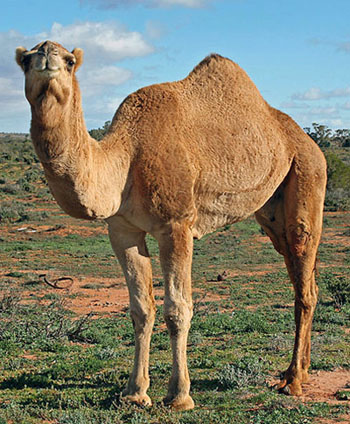Camels in Canada
Today, camels in Canada. The University of Houston's College of Engineering presents this series about the machines that make our civilization run, and the people whose ingenuity created them.
In another program, I talk about Dromedary camels that the US Army imported into Texas in 1856. Those, it turned out, were only part of more widespread move to bring camels to America -- or perhaps I should say bring back. Camels originated in the west, migrated to Asia some four million years ago; then they finally died out here only 10,000 years ago -- probably hunted to extinction. Llamas, Alpacas and Vicunas are actually forms of camels.
America, then fascinated by Eastern and Middle Eastern exotica, saw that camels could make fine beasts of burden in its arid Southwest. A large Dromedary or Bactrian camel is a great load carrier, even if it becomes less romantic at close quarters.

In any case, the Confederate Army captured the Texas Camels during the Civil War and used them to move cotton into Mexican ports. Meantime, private promoters in San Francisco also saw the potential for camels. They realized that two-humped Bactrian camels could carry even more freight than Dromedaries.

So they began importing Bactrians from Manchuria. Some were sent to Los Angeles. In fact, someone even tried to set up a camel express service between Southern California and Arizona.
But the camel saga takes a strange northward turn with the discovery of gold in British Columbia's Cariboo region -- off in the mountains two hundred miles north of Vancouver. One John Calbreath quickly bought 23 of the San Francisco Bactrian camels at three hundred dollars each. He had them shipped to Vancouver Island. From there they were put on a barge and taken to the Frasier River. There they went to work hauling goods into the mountains.
Yet they were greeted with less than enthusiasm. A newspaper editorial wondered if they'd be followed by trained whales who would move people in Jonah fashion. The camels terrified stagecoach horses and they would eat anything loose -- unwashed laundry, leather tackle, even soap. Their complex digestive and urinary processing systems also gave them a peculiar -- and very strong --stench.
Cultures that use camels treat them with a special reverence. Cultures that don't are likely to view them as noxious necessities. That's what happened both in Canada and the southern US. They were very effective -- sure-footed and able to carry nearly a third of a ton of goods. But they suffered fools badly -- rewarded bad treatment with anger and stubborn resistance. The marriage of miners and Bactrians eventually failed. Many camels were simply left to wander into the woods.
Long afterward, they and their offspring have been seen. Stories abound. In fact the stench attributed to Sasquatch sounds much like the stench of a Bactrian camel. And, when you look at a Bactrian face on, in can seem oddly hominid.
So, bringing camels back to their once-home-continent failed in many places. That failure appears to've been less a matter of an inhospitable climate than a matter of inhospitable humans.
I'm John Lienhard at the University of Houston, where we're interested in the way inventive minds work.
P. C. Newman, The Story of the Hudson's Bay Company: Vol. II, Caesars of the Wilderness, Company of Adventurers. (Markham, Ontario, Viking, Penquin Books, 1987): pp; 311-312. See the Wikipedia articles on
the Cariboo camels;
and on Camels in general.
Here's another article on camels in general,
This is a fanciful legendary account of the Cariboo camels,
More on the camels in the Southwest,
and one the camels in Texas.
The two photos are courtesy of Wikipedia Commons. The drawing of a Dromedary and Bactrian below was used to call up the romance of the Mideast in an 1883 illustrated Bible.
